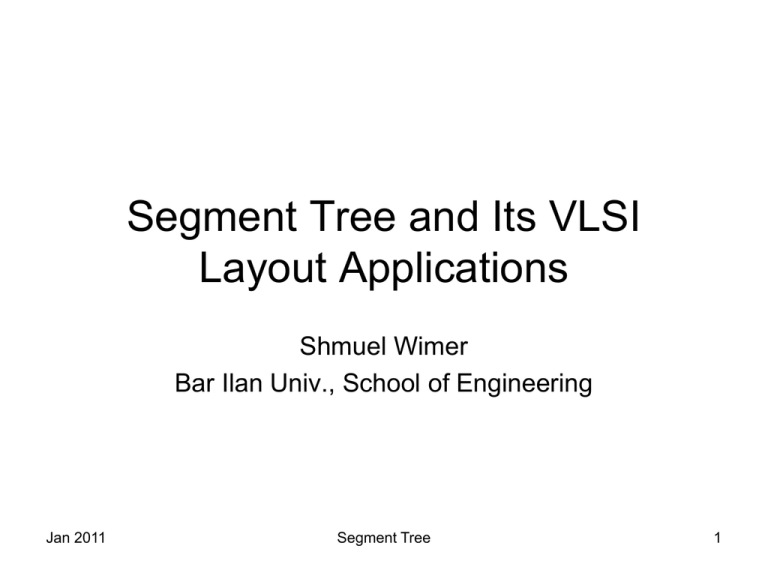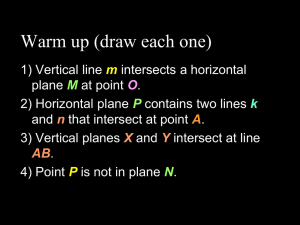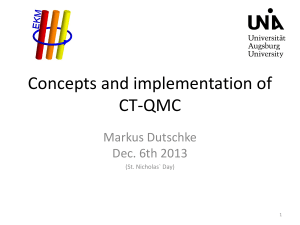3. Segment Tree Applications
advertisement

Segment Tree and Its VLSI
Layout Applications
Shmuel Wimer
Bar Ilan Univ., School of Engineering
Jan 2011
Segment Tree
1
Segment Tree Definition
• Introduced by J. L. Bentley in 1977
• Data structure designed to handle intervals on the real
line
• Intervals end points belong to a fixed set of abscissas
• Abscissas can be normalized to range [1,N] without loss
of generality by using a lookup table
• Given an interval [l,r], the segment tree T(l,r) is a rooted
binary tree defined recursively
Jan 2011
Segment Tree
2
Every node v is characterized by two parameters
B v : beginning of node's world (left end)
E v : end of node's world (right end)
If r l 1 a midpoint B v E v 2 is defined and two
sub-trees dividing v's world into two halves are rooted at v :
LSON v is the root of a left sub-tree T l , B v E v 2
RSON v is the root of a right sub-tree T B v E v 2 , r
Jan 2011
Segment Tree
3
v
T l, r
RSON v
LSON v
T l , B v E v 2
T B v E v 2 , r
The intervals B v , E v
are called standard intervals of T
vT
The unit intervals stored at leaves (r l 1) are called elementry
intervals of T
Jan 2011
Segment Tree
4
4,15
4,9
9,15
4,6
4,5
6,9
5,6
9,12
6,7
7,9
7,8
Jan 2011
9,10
8,9
Segment Tree
12,15
10,12
10,11
11,12
12,13
13,15
13,14
14,15
5
Insertion and Deletion
Segment tree is a ststic data structure w.r.t the set of abscissae.
It is designed to dynamically store intervals whose ends belong
to a set l , l 1,, r 1, r , namely, supporting insertions and
deletions.
For r l 3, an interval l , r is partitined into log 2 r l +
log 2 r l 2 standard intervals of T l , r at most, hence
for a set of n interval with 2n distinct ends, the total number
of standard intervals is bounded by O n log 2 n .
Jan 2011
Segment Tree
6
void INSERT / DELETE (int b, int e, node v) {
if ((b B v ) and (E v e)) {
allocate / de-allocate b, e to v;
}
else {
if (b B v E v 2 ) { INSERT / DELETE (b, e, LSON v ) }
if ( B v E v 2 e) { INSERT / DELETE (b, e, RSON v ) }
}
UPDATE (v) ; // application specific, computed at recurrence exit
}
Jan 2011
Segment Tree
7
PIN
1,257
74,107
1,129
65,129
65,97
65,81
97,129
81,97
PL
97,115
97,105
73,81
105,115
77,81
73,77
105,109
73,75
PR
75,77
105,107
74,75
Jan 2011
Segment Tree
8
The action INSERT (b, e, ROOT (T )) / DELETE (b, e, ROOT (T )) imposes
a tour in T , having the following structure:
An initial path PIN (possible empty) starting at the root and ending at a
node v* called fork.
From v* two (possibly empty) path PL and PR issue. Either b, e is
allocated entirely to v* (then PL and PR are empty), or all right sons
of PL , which are not on PL , and all left sons of PR , which are not on
PR , are allocated (de-allocated), thus defining b, e fragmantation
into standard intervals.
Jan 2011
Segment Tree
9
Allocation and De-Allocation
• Depends on application.
• If we wish to know the cardinality of cover of [B[v],E[v]]
then a counter C[v] is associated with node v:
– C[v] = C[V]+1 is allocation for INSERT
– C[v] = C[V]-1 is de-allocation for DELETE
• In many cases of VLSI aplication C[v] indicates the
presence of material, so we’ll be interested in whether
C[v] > 0 (material exists) or C[v]==0 (no material).
Jan 2011
Segment Tree
10
VLSI Layout Applications
• Useful for calculating area and perimeter of polygon
ensemble for lateral and fringe capacitance extraction.
• Mask Boolean operations like UNION, INTERSECTION,
DIFFERENCE, and more, where contour is required.
– Construction (contour) problems are typically more difficult than
reporting (area, perimeter) problems.
• More applications:
– Design rule checking.
– Cross coupling capacitance
• Very robust and simple for implementation. There are
other, more efficient and more complex data structures.
Jan 2011
Segment Tree
11
This is what mask
designer is drawing
This data is used by lithography
for mask generation, obtained
by UNION operation
We may be interested in calculating the underling area for extracting lateral
capacitance and the perimeter for the extraction of fringe capacitance
Jan 2011
Segment Tree
12
This is what mask
designer is drawing
This is the diffusion
mask for manufacturing
obtained by Boolean
DIFFERENCE
Jan 2011
Segment Tree
13
The electric field between the
metal wires implies line-to-line
capacitance, which is the
reason of noise and power
dissipation
This is what mask designer is drawing
L
D
We’d like to calculate the common parallel run L and
the distance D so the line-to-line capacitance is L/D
Jan 2011
Segment Tree
14
1D Measure of Union of Intervals
Given n intervals b1 , e1 ,
, bn , en in the real line, how efficiently their measure
of UNION can be found?
We sort the abscissae b1 , e1 , b2 , e2 ,
, bn , en in ascending order p1 , p2 ,
, p2 n
and associating to every point whether it was an opening (left) or closing (right)
end point of an interval. In case of tie, openning end point preceeds closing one.
Jan 2011
Segment Tree
15
Let m be the measure of UNION and C the multiplicity of overlapping intervals.
void 1D_MEASURE_OF_UNION( intervals
obtain p1 , p2 ,
bi , ei
n
i 1
){
, p2 n in ascending order ;
m 0 ; C 1 ; // initialize measure and multiplicity (cardinality) of cover
for ( i 2 ; i 2n ; i ) {
if ( C 0 ) { m m pi pi 1 }
if ( pi is left (opening) end point ) { C C 1 }
else { C C 1 } // pi is closing end point
}
}
Jan 2011
Run time is O n log2 n.
Segment Tree
16
2D Measure (Area) of Union of Rectangles
Problem: How to calculate the area of UNION without double counting
overlapping areas?
Consider an imaginary vertical line is
positioned at abscissa x, intersecting
the rectangles with measure m x .
The area of UNION of rectangles is
then given by
-
m x dx.
We'll simulate the imaginary vertical
line, called scan - line or sweep - line
in a discrete mannar.
Jan 2011
Segment Tree
17
Given rectangles Ri i 1 , let x1 , x2 ,
n
, x2 n be their abscissae sorted in ascending
order (left-to-right). Associate with an abscissa whether it belongs to an openning
(left) or closing (right) edge. In case of tie in x, openning edge preceeds closing one.
scan-line
The projection (measure) of
the UNION of rectangles on
the scan-line can cahnge only
at abscissae of edges and
remains constant at the semiopen interval xi , xi 1 .
The area increment is obtained
by m xi xi 1 xi .
Jan 2011
xi
xi 1
Segment Tree
18
Efficient Calculation of m(xi)
Calculating m xi efficiently is the key of the 2D algorithm and is obtained
in O log 2 n time by segment tree implementation of the scan-line.
Since the ordinates of the vertical edges (position of horizontal edges) are known
apriori and their count is 2n at most, an appropriate segment tree T 1, 2n can be
constructed.
An opening (left) edge triggers an insertion into T 1, 2n , while closing (right)
edge triggers deletion. Every insertion or deletion to v T 1, 2n updates C v
(number of rectangles covering the node). Area is contributed iff C v 0.
A parameter m v is associated to a node v, indicating how much of the segment
B v , E v is covered by the rectangles at xi . Clearly, m root T m xi .
Jan 2011
Segment Tree
19
void INSERT / DELETE (int b, int e, node v) {
if ((b B v ) and (E v e)) { C v / C v }
else {
if (b B v E v 2 ) { INSERT / DELETE (b, e, LSON v ) }
if ( B v E v 2 e) { INSERT / DELETE (b, e, RSON v ) }
}
if ( C v 0 ) { m v =E v B v } // node is fully covered
else { // node is either partially covered or empty
if ( v is not a leaf ) { m v =m LSON v m RSON v }
else { m v =0 }
}
}
Given a vertical edge at abscissa xi and ordinates bi , ei , the measure
m root T m xi is obtained in O log 2 n time.
Jan 2011
Segment Tree
20
void 2D_MEASURE_OF_UNION ( rectangles Ri i 1 ) {
n
sort vertical edges of retngles in ascending order x1 , x2 ,
, x2 n ;
Initialize root of tree ;
construct segment tree T spanning min bi , max ei ;
1i 2 n
1i 2 n
m 0 ; // measure initalization
for ( i 1 ; i 2n ; i ) {
if ( i 1 ) { m m root T xi xi 1 }
if ( xi is opening / closing ) {
INSERT / DELETE (bi , ei , root T ) ;
}
}
Overall run-time is O n log2 n. Overall storage is O n .
Jan 2011
Segment Tree
21
Perimeter of Union of Rectangles
m xi - m xi -1
m xi-1 m xi
Perimeter is the length sum of:
vertical edges
horizontal edges
Observation: m xi - m xi -1 is the vertical contribution to perimeter
resulting from insertion or deletion of an edge.
Jan 2011
Segment Tree
22
i 2
i 6
xi 1 xi
xi 1 xi
Horizontal contribution is added along scan-line progression. If i = 2 number
of scan-line intersections in xi 1 , xi . Contribution to perimeter is i xi xi 1 .
Jan 2011
Segment Tree
23
How to compute i efficiently along scan-line progression? Let F
n
i 1
Ri .
v 2 number of the scan-line S x F intersections with
B v , E v .
1 B v S x F
LBD v
otherwise
0
B v , E v
1 E v S x F
RBD v
otherwise
0
B v , E v
LBD v and RBD v avoid double counting of horizontal edges in case
that a continous segment is split between two sons.
Jan 2011
Segment Tree
24
B v
v
E v
B v E v 2
RBD 1
LBD 1
v , LBD v and RBD v are maintained at every INSERT and
DELETE.
Jan 2011
Segment Tree
25
void UPDATE ( node v ) {
if ( C v 0 ) { v 2 ; LBD v RBD v 1 ; }
else {
v LSON v RSON v
2 RBD LSON v LBD RSON v ;
RBD v RBD RSON v ;
LBD v LBD LSON v ;
}
}
The term 2 RBD LSON v LBD RSON v compensates for the
case of artificail split between the two sub-trees of sons.There exists
i ROOT T .
Jan 2011
Segment Tree
26
void PERIMETER_OF_UNION ( rectangles Ri i 1 ) {
n
sort vertical edges of retngles in ascending order x1 , x2 ,
, x2 n ;
construct segment tree T spanning min bi , max ei ;
1i 2 n
1i 2 n
mo 0 ; p 0 ; // measure and perimeter initalization
for ( i 1 ; i 2n ; i ) {
* root T ; // take at the beginning of xi 1 , xi
if ( xi is openning / closing ) {
INSERT / DELETE (bi , ei , root T )
}
m* m root T ; p m* mo ; // vertical contribution
mo m* ; // store old measure
if ( i 1 ) { p * xi xi 1 } // horizontal contribution
}
Jan 2011
Segment Tree
27
Overall time is O n log2 n . Overall storage is O n .
Questions : What happens if edges have same abscissa and closing edges
are preceding opening ones?
Although material is continuous when two rectangles are abutting, the edge
of abutment will be accounted twice in perimeter!
Edges are sorted such that for same abscissa opening edges are preceding
closing ones.
Jan 2011
Segment Tree
28
The Contour of Union of Rectangles
Given a collection of rectangles Ri i 1 , find the contour of F
n
n
i 1
Ri .
Rectangles are counterclockwise oriented. Hence contour is also oriented.
Resulting countour orientation must be consistent. External countours are
counterclockwise oriented. Internal contours (holes) clockwise oriented.
Jan 2011
Segment Tree
29
S c
S c
F
E
A left (opening) edge E is located at abscissa c.
What portion it contributes to the contour?
E
Jan 2011
Segment Tree
S c F ,
>0
30
S c
S c
E
F
A right (closing) edge E is located at abscissa c.
What portion it contributes to the contour?
E
Jan 2011
Segment Tree
S c F ,
>0
31
Two phase algorithm (Lipski - Preparata 1980):
Find the set V of vertical edges of contour of UNION
Link the vertical edges in V by horizontal edges to form properly oriented cycles.
Derivtion of V is done by a segment tree implementation of scan-line. Let S c
denote vertical scan-line at abscissa c. The intersection S c F consists of a
set of disjoint vertical intervals.
Let x1 , x2 ,
, x2 n be the sorted abscissae of Ri i 1 . S x F doesn't change
n
at the open interval xi x xi 1.
Jan 2011
Segment Tree
32
The meaning of c with regard to scan-line is that the contribution of
a left (opening) edge is computed before edge INSERT takes place.
Similarily, c means that the contribution of a right (closing) edge is
computed after edge DELETE takes place.
In addition to standard segment-tree parameters of a node v, we define
1 C u 0 u T v
a potential indicator P v
0 otherwise
Initiaization: C v =0 and P v =1 at construction of the segment-tree.
S x F B v , E v
C v 0 , so its complement is the gaps
between these intervals, which are found with the aid of C v and P v .
Jan 2011
Segment Tree
33
The contribution S x
F
E of an edge E : b, e is given by:
C v 0
CONTR v B v , E v
P v 1
P v 0
CONTR LSON v CONTR RSON v
Edge E : b, e is INSERT (DELETE)
Decomposed into standard intervals
Scan-line intersection with F
n
i 1
Ri
E : b, e intersection with complement
E : b, e
Problem: contiguous segments are split
S x F
Jan 2011
E
S x F
Segment Tree
34
The formation of contiguous segments of E
S x F is obtained by using
a STACK data structure. Traversal of E decomposition into standard intervals
is done left-to-right, hence abutment across standard intervals can be detected
on-the-fly.
Set STACK at any new abscissa of sorted x1 , x2 ,
, x2 n .
if ( B v TOP STACK ) { TOP STACK E v } // contiguous
else { B v STACK ; E v STACK ; } // start new segment
Edges are sorted such that for same abscissa openning edges are preceding
closing ones. Opening (closing) edges having same abscissa are sorted in
ascending order of their lower ordinate to ensure contiguity and uniqueness.
Jan 2011
Segment Tree
35
void CONTR (int b, int e, node v) {
if (C v ==0) { // C v >0 implies B v , E v
S x F
if ((b B v ) and (E v e) and (P v 1)) { // contribution to contour
if ( B v TOP STACK ) { TOP STACK E v } // contiguous
else { B v STACK ; E v STACK ; } // start new segment
}
else {
if (b B v E v 2 ) { CONTR (b, e, LSON v ) }
if ( B v E v 2 e) { CONTR (b, e, RSON v ) }
} } }
Jan 2011
Segment Tree
36
void INSERT / DELETE (int b, int e, node v) {
if ((b B v ) and (E v e)) { C v / C v }
else {
if (b B v E v 2 ) { INSERT / DELETE (b, e, LSON v ) }
if ( B v E v 2 e) { INSERT / DELETE (b, e, RSON v ) }
}
if ( C v >0 ) { P v =0 } // node cannot contribute to contour
else if ( v is a leaf ) { P v =1 } // node can contribute to contour
// node inherits contribution potential from sons
else if ((P LSON v ==1) and (P LSON v ==1)) { P v =1 }
else { P v =0 } // contribution may come from lower nodes
}
Jan 2011
Segment Tree
37
void VERTICAL_EDGES_OF_CONTOUR ( rectangles Ri i 1 ) {
n
sort vertical edges of rectangles in ascending order x1 , x2 ,
, x2 n ;
construct segment tree T spanning min bi , max ei ;
1i 2 n
1i 2 n
V ; STACK ; // initalization
for ( i 1 ; i 2n ; i ) { // contribution preceds edge insertion
if ( xi is opening ) {
CONTR (bi , ei , ROOT T ) ; INSERT (bi , ei , ROOT T ) ;
}
else { // contribution proceeds edge deletion
DELETE (bi , ei , ROOT T ) ; CONTR (bi , ei , ROOT T ) ;
}
if (( xi 1 > xi ) or (opening / closing status change)) {
V V
STACK ; STACK ;
} } }
Jan 2011
Segment Tree
38
Completing the Cycles of Contour
Denote by x ; b, t vertical edge b, t at abscissa x and by y ; l , r horizontal
edge l , r at ordinate y. Horizontal edge of contour is supported by two vertical
edges.
x1 ; y1, y2
x1 , y1
x1 , y2
; y1
y1 ; x1, x2
; y2
x2 , y1
x2 , y0
; y0
x2 ; y0 , y1
; y1
Associate to every vertical edge e j V , e j x j ; b j , t j , two triplets
x ,b ; t
j
j
Jan 2011
j
and
x ,t ; b
j
j
j
pointing to each other.
Segment Tree
39
Let V q. We sort
x , y ; z
j
j
j
, 1 j 2q, lexicoraphically in ascending
order by y j as primary key and x j as secondary key. (Why all triplets must be
distinct?)
Let
x , y ; z
1
1
1
,
, x2 q , y2 q ; z2 q
be sorted. It is possible by traversal
over it and by usage of triplets mutual pointers to construct all contour cycles
in consistent directions (external contours and holes).
Traversal takes time linear in triplet list, so O q log q sorting time defines
run-time complexity.
The resulting countor may consist of several cycles. Counterclockwise oriented
contours are the external boundary of polygons, while clockwise oriented cycles
are holes of polygons.
Jan 2011
Segment Tree
40
e3
e6
e8
e5
e7
e1
e10
e2
e9
e4
Edges ei , 1 i 10, were obtained
in this order by first scan-line part.
x2 , b2 ;t2 x4 , b4 ;t4 x4 , t4 ; b4 x9 , b9 ;t9 x9 , t9 ;b9 x10 , b10 ;t10
x5 , b5 ;t5
x7 , b7 ;t7 x1 , b1 ;t1
x3 , b3 ;t3
x6 , b6 ;t6 x8 , b8 ;t8 x8 , t8 ;b8
Jan 2011
x7 , t7 ;b7
x1 , t1 ;b1
x10 , t10 ;b10 x3 , t3 ;b3
x6 , t6 ;b6
x2 , t2 ;b2 x5 , t5 ;b5
Segment Tree
41
There’s no ambiguity in deciding whether to go to left or right triplet when
an horizontal edge is decided.
It follows that a pair of successive triplets defines horizontal edges.
Consequently, once two successive triplets are traversed and define a new
horizontal edge, the number of triplets on both the left and the right parts of
the list must be even.
Therefore, if the index of a triplet is even, its left adjacent triplet is paired,
otherwise, the right triplet is paired.
Jan 2011
Segment Tree
42
Run-time Complexity
Lemma : Let T be a balanced binary tree with n leaves and L a subset
of its nodes. Denote by P u the set of nodes on the paths from u L to
the root. Total number of nodes along the paths satisfies:
P u L log 2
uL
16n
.
L
Proof : We can assume that L is a subset of T 's leaves, as this is the
worst case, yielding the longest and least overlapping paths to root.
Let T L be the tree whose leaves are L and T0 L T L containing
v T L whose parent or v itself has at least two descendants in L.
Jan 2011
Segment Tree
43
The number of leaves in T0 L is L. This
follows since a leaf is either in both T0 L
and T L , or if a leaf u is in T L \T0 L
then a path to root P u must enter T0 L .
Also, two paths P u and P u , u L
and u L cannot merge at a laef of T0 L .
T L consists of a "top" part T0 L whose L leaves are 1:1 connect with
disjoint paths (a path is possible empty) to the leaves of T L .
Jan 2011
Segment Tree
44
Given fixed L, The largest T L is obtained when T0 L is balanced and
topmost in T L . This follows since two paths in T L connecting leaves
to root are merged as close as possible to root, resulting in maximal count
of distinct nodes of the two paths.
U’
U”
U’
|P(U’)+ P(U”)|=7
U”
|P(U’)+ P(U”)|=5
T L 2 L 1 L log 2 n log 2 L
L 2 log 2 n 1 log 2 L 1 L log 2
Jan 2011
Segment Tree
16n
. Q.E.D
L
45
Consider the contribusion to contour ocurring by an edge Ei , 1 i 2n,
in CONTR. Let ni be the number of distinct pieces of Ei
S x F .
There are 3 possibilities for a node v in CONTR. If C v >0 traversal
is aborted. P v =1, whole node's interval B v , E v is contributed
and traversal is aborted.
Most time consuming part occurs at partially covered nodes,
C v =0 and P v =0. Contribution is made by recursive call
of CONTR and decomposition into contiguous standard
intervals obtained along the left and right paths issued at v.
Jan 2011
Segment Tree
46
Each of the ni disjoint pieces of Ei
S x F results in
at most two search paths terminating at most in two leaves.
Hence the total constribution of ni such searches is 2ni
leaves at most, with a constant amount of work at each node.
Let p i 1 ni be the total amount of contour vertical pieces.
2n
By Lemma the total node visits (paths overlap included) is
16n
bounded by C i 1 2ni log 2
.
2ni
2n
Jan 2011
Segment Tree
47
Since p i 1 ni ,
2n
i1 2ni log 2
2n
16n
is maximized for ni = p 2n .
2ni
Hence, the number of visited nodes is bounded by
64n 2
16n 2
2n p
16n
.
Cp log 2
C i 1 log 2
C i 1 2ni log 2
p
p
n
2ni
2n
INSERT and DELETE are standard and consume O n log 2 n ,
and same for intial sort of input vertical edges. Building initial
segment tree is O n .
Theorem : The p edge contour of UNION of n isothetic
rectangles can be found in O n log 2 n p log 2 n 2 p .
Jan 2011
Segment Tree
48
Theorem : The run-time complexity of finding a contour of
F
n
i 1
Ri without holes is bounded by n log 2 n .
Proof : We'll show that the problem sorting N numbers
x1 , x2 ,
, xn can be transformed in time O n into finding
the contour of UNION of rectangles. Let x1 , x2 ,
, xn be
arbitrary real positive numbers. We define
Ri : x, y 0, xi 0, M xi , 1 i n, M max xi 1.
1i n
Jan 2011
Segment Tree
49
Finding the contour solves the sorting problem,
known to be bounded by n log 2 n . Q.E.D
Jan 2011
Segment Tree
50








